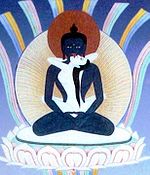Atiyoga: Difference between revisions
m (→Entry Point) |
m (→Entry Point) |
||
| (2 intermediate revisions by 2 users not shown) | |||
| Line 1: | Line 1: | ||
{{Template:9yanas articles | |||
'''Atiyoga''' (Skt.; Tib. | |title=9. Yana of atiyoga | ||
|sanskrit=atiyoga yāna | |||
|tibetan=[[ཤིན་ཏུ་རྣལ་འབྱོར་གྱི་ཐེག་པ་]] | |||
|phonetics=shintu naljor kyi tekpa | |||
|wylie=shin tu rnal 'byor gyi theg pa | |||
}} | |||
'''Atiyoga''' (Skt.; Tib. ཤིན་ཏུ་རྣལ་འབྱོར་, [[Wyl.]] ''shin tu rnal 'byor'') — the highest [[yana]] within the classification of [[nine yanas]] of the [[Nyingma]] school. Atiyoga is synonymous with [[Dzogchen]]. | |||
==Overview Given by [[Alak Zenkar Rinpoche]]<ref>{{LH|tibetan-masters/alak-zenkar/nine-yanas|''A Brief Presentation of the Nine Yanas'' by Alak Zenkar Rinpoche}}</ref>== | ==Overview Given by [[Alak Zenkar Rinpoche]]<ref>{{LH|tibetan-masters/alak-zenkar/nine-yanas|''A Brief Presentation of the Nine Yanas'' by Alak Zenkar Rinpoche}}</ref>== | ||
The vehicle of Atiyoga, or ‘Utmost Yoga,’ is so-called because it is the highest of all vehicles. It involves the realization that all phenomena are nothing other than the appearances of the naturally arising [[primordial wisdom]] which has always been beyond arising and ceasing. | The vehicle of Atiyoga, or ‘Utmost Yoga,’ is so-called because it is the highest of all vehicles. It involves the realization that all phenomena are nothing other than the appearances of the naturally arising [[primordial wisdom]] which has always been beyond arising and ceasing. | ||
===Entry Point=== | ===Entry Point=== | ||
One’s mind is matured through the four ‘expressive power of awareness’ empowerments (Tib. | One’s mind is matured through the four ‘expressive power of awareness’ empowerments (Tib. རིག་པའི་རྩལ་དབང་, ''rigpé tsal wang''), and one keeps the [[samaya]]s as explained in the texts. | ||
===View=== | ===View=== | ||
The view is definitively established by looking directly into the naturally arising wisdom in which the three kayas are inseparable: the [[empty essence]] of naked awareness beyond the [[ordinary mind]] is the [[dharmakaya]], its [[cognizant nature]] is the [[sambhogakaya]], and its [[all-pervasive compassionate energy]] is the [[nirmanakaya]]. | [[Image:Samantabhadra.jpg|thumb|150px|The Primordial Buddha [[Samantabhadra]]]] | ||
The view is definitively established by looking directly into the naturally arising wisdom in which the three kayas are inseparable: the [[essence|empty essence]] of naked awareness beyond the [[ordinary mind]] is the [[dharmakaya]], its [[nature|cognizant nature]] is the [[sambhogakaya]], and its [[compassionate energy|all-pervasive compassionate energy]] is the [[nirmanakaya]]. | |||
===Meditation=== | ===Meditation=== | ||
| Line 21: | Line 27: | ||
===Results=== | ===Results=== | ||
Perfecting the [[four visions]] of the path, one gains the supreme kaya, the rainbow body of great transference (see [[rainbow body]]), and attains the level of glorious [[Samantabhadra]], the thirteenth [[bhumi]] known as ‘Unexcelled Wisdom’ (''yeshe lama''). | Perfecting the [[four visions]] of the path, one gains the supreme kaya, the rainbow body of great transference (see [[rainbow body]]), and attains the level of glorious [[Samantabhadra]], the thirteenth [[bhumi]] known as ‘Unexcelled Wisdom’ (''yeshe lama''). | ||
==Notes== | ==Notes== | ||
Latest revision as of 21:57, 10 April 2021
| The Nine Yanas |
| 9. Yana of atiyoga |
| Skt. atiyoga yāna |
| Tib. ཤིན་ཏུ་རྣལ་འབྱོར་གྱི་ཐེག་པ་ |
| shintu naljor kyi tekpa |
| Wyl. shin tu rnal 'byor gyi theg pa |
| Read main article for nine yana overview |
| Three Outer Yanas Leading From the Origin |
| 1. Shravaka yana |
| 2. Pratyekabuddha yana |
| 3. Bodhisattva yana |
| Three Yanas of Vedic Asceticism |
| 4. Yana of kriya tantra |
| 5. Yana of charya tantra |
| 6. Yana of yoga tantra |
| Three Yanas of Powerful Transformative Methods |
| 7. Yana of tantra mahayoga |
| 8. Yana of scriptural transmission anuyoga |
| 9. Yana of pith instruction atiyoga |
Atiyoga (Skt.; Tib. ཤིན་ཏུ་རྣལ་འབྱོར་, Wyl. shin tu rnal 'byor) — the highest yana within the classification of nine yanas of the Nyingma school. Atiyoga is synonymous with Dzogchen.
Overview Given by Alak Zenkar Rinpoche[1]
The vehicle of Atiyoga, or ‘Utmost Yoga,’ is so-called because it is the highest of all vehicles. It involves the realization that all phenomena are nothing other than the appearances of the naturally arising primordial wisdom which has always been beyond arising and ceasing.
Entry Point
One’s mind is matured through the four ‘expressive power of awareness’ empowerments (Tib. རིག་པའི་རྩལ་དབང་, rigpé tsal wang), and one keeps the samayas as explained in the texts.
View

The view is definitively established by looking directly into the naturally arising wisdom in which the three kayas are inseparable: the empty essence of naked awareness beyond the ordinary mind is the dharmakaya, its cognizant nature is the sambhogakaya, and its all-pervasive compassionate energy is the nirmanakaya.
Meditation
The meditation consists of the approach of cutting through resistance to primordial purity (Tib. kadak trekchö), through which the lazy can reach liberation without effort, and the approach of the direct realization of spontaneous presence (Tib. lhundrup tögal), through which the diligent can reach liberation with exertion.
Conduct
The conduct is free from hope and fear and adopting and abandoning, because all that appears manifests as the display of reality itself.
Results
Perfecting the four visions of the path, one gains the supreme kaya, the rainbow body of great transference (see rainbow body), and attains the level of glorious Samantabhadra, the thirteenth bhumi known as ‘Unexcelled Wisdom’ (yeshe lama).
Notes
Further Reading
- Jamgön Kongtrul, The Treasury of Knowledge, Book Six, Part Four: Systems of Buddhist Tantra, translated by Elio Guarisco and Ingrid McLeod (Ithaca: Snow Lion, 2005), pages 337-346.